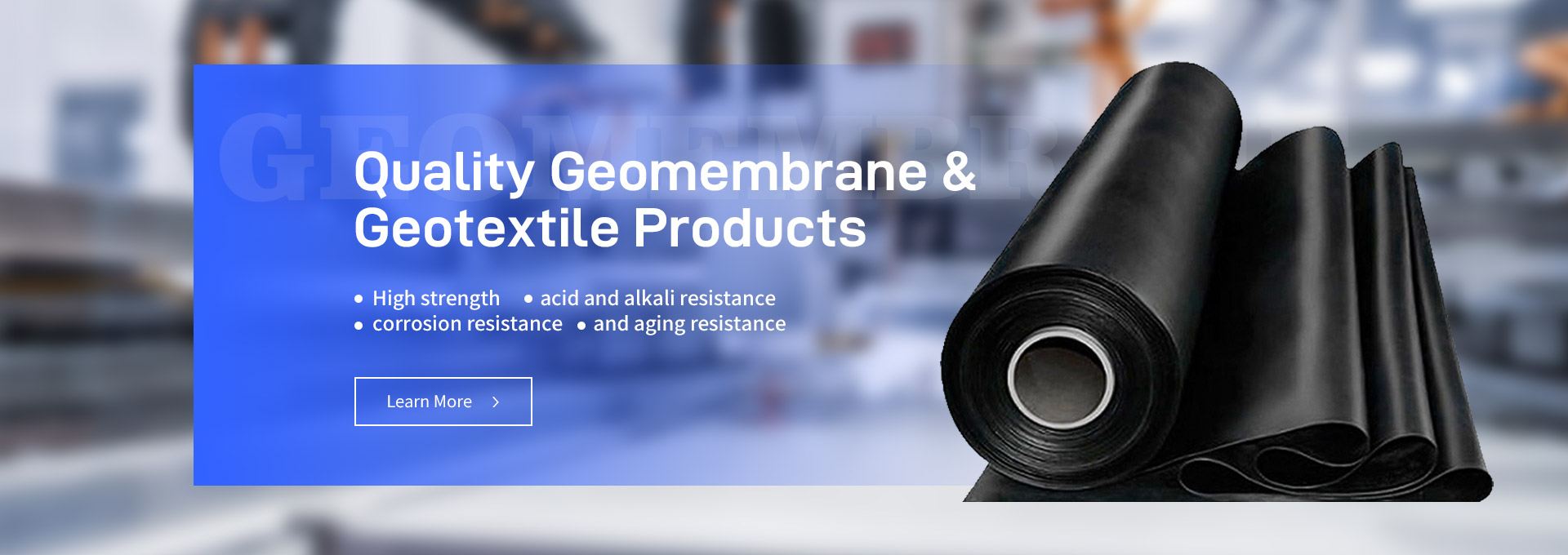With the rapid pace of global industrialization and urbanization, wastewater treatment has become one of the major challenges of modern society. If industrial sewage, agricultural runoff, and urban wastewater are not properly managed, they can pollute water sources and cause long-term damage to soil and ecosystems. To address these issues, an increasing number of wastewater treatment projects are utilizing sewage pond geomembranes as a crucial protective measure. These geomembranes not only prevent leakage in sewage ponds but also significantly enhance the efficiency and environmental sustainability of wastewater management systems.
Ⅰ. What is a Sewage Pond Geomembrane?
A sewage pond geomembrane is an engineered material used in wastewater ponds and other liquid containment facilities, typically made from high-density polyethylene (HDPE), linear low-density polyethylene (LLDPE), polyvinyl chloride (PVC), and other polymer materials. Its primary function is to prevent wastewater, chemicals, and other hazardous substances from penetrating into groundwater or soil, ensuring that these contaminants are properly contained and treated.
The design and use of geomembranes aim to address the leakage problems commonly encountered in traditional wastewater treatment systems. Geomembranes are widely used not only in wastewater treatment plants but also in industrial wastewater ponds, agricultural reservoirs, and landfill sites that require liquid containment.

Ⅱ. How Does a Geomembrane Protect Water Resources?
1. Preventing Wastewater Seepage
The primary function of a sewage pond geomembrane is to prevent wastewater from seeping into the ground and contaminating groundwater sources. Untreated wastewater often contains large amounts of harmful substances, including heavy metals, chemical waste, and pathogens. If these substances infiltrate groundwater, they can cause severe environmental pollution and pose risks to drinking water safety.
High-quality geomembranes provide exceptional impermeability, effectively blocking moisture and contaminants from passing through their material layers. This barrier not only protects groundwater but also extends the lifespan of the sewage treatment pond.
2. Preventing Groundwater Intrusion
In addition to preventing wastewater leakage, geomembranes can also stop groundwater from seeping into sewage ponds. In areas with high rainfall or elevated groundwater levels, external water might infiltrate the pond, diluting the wastewater and reducing treatment efficiency. Moreover, the intrusion of groundwater could destabilize the pond’s structure, increasing maintenance and operational costs.
The dual-protection function of geomembranes ensures the pond's integrity, preventing both the escape of contaminants and the intrusion of external water, thus improving the overall efficiency of the wastewater treatment system.
3. Resisting Chemical Corrosion
Wastewater in sewage ponds often contains various chemical substances, especially in industrial wastewater treatment, where these chemicals can be highly corrosive. Without effective protective measures, the structure of the sewage pond may corrode, leading to breakages and leakage of contaminants. Sewage pond geomembranes are made from chemically resistant materials that can withstand prolonged exposure to acids, bases, and salts, ensuring the safety and longevity of the pond.
4. Reducing Environmental Pollution Risks
By using geomembranes, sewage ponds can effectively seal and contain pollutants, reducing their direct impact on the surrounding environment. This not only helps maintain ecological balance but also lowers the cost of environmental remediation. The use of geomembranes controls the spread of pollutants from the source, serving as a crucial measure in minimizing environmental risks during wastewater treatment.
Ⅲ. Choosing the Right Material for a Geomembrane
The type and properties of the material used for sewage pond geomembranes are critical to their impermeability, durability, and suitability for specific environments. Below are some common geomembrane materials and their advantages and disadvantages.
1. High-Density Polyethylene (HDPE)
HDPE is one of the most commonly used materials for sewage pond geomembranes due to its excellent chemical resistance, durability, and UV resistance. HDPE geomembranes are ideal for most sewage ponds, especially when dealing with wastewater containing strong acids, alkalis, or other corrosive chemicals.
Advantages:
High impermeability and long-term durability.
Excellent resistance to chemical corrosion, making it suitable for industrial wastewater.
Long service life, ideal for long-term applications.
Disadvantages:
Less flexible, requiring more careful handling during installation to avoid damage to the membrane.
2. Linear Low-Density Polyethylene (LLDPE)
LLDPE offers greater flexibility compared to HDPE, making it suitable for applications in complex terrains or locations requiring high adaptability. LLDPE membranes are known for their resistance to cracking and durability while still providing good impermeability.
Advantages:
Greater flexibility, ideal for irregular terrains.
Easier installation, offering broader applicability.
Disadvantages:
Slightly less chemical resistance compared to HDPE.
3. Polyvinyl Chloride (PVC)
PVC geomembranes are known for their flexibility and ease of welding, making them suitable for small sewage ponds or environments with low chemical corrosion. While they are easy to install, PVC membranes have weaker UV resistance, making them more suitable for underground or covered environments.
Advantages:
Relatively low cost, suitable for budget-conscious projects.
Easy to weld, making installation simpler.
Disadvantages:
Not resistant to UV exposure, prone to degradation under sunlight.
Less durable in highly corrosive environments compared to HDPE and LLDPE.
Ⅳ. Installation and Maintenance of Sewage Pond Geomembranes
While geomembranes significantly improve the safety and efficiency of wastewater treatment systems, their proper installation and maintenance are crucial to their effectiveness and longevity.
1. Installation Considerations
The installation of geomembranes requires professional expertise to ensure that the membrane is tightly bonded to the pond structure. Sharp objects should be avoided during installation to prevent damage to the membrane, and the seams must be welded securely to avoid future leaks. Once installation is complete, a comprehensive leak test should be conducted to ensure the membrane is flawless.
2. Regular Inspection and Maintenance
Although geomembranes have a long service life, regular inspection and maintenance are essential. In high-corrosion environments, membranes may gradually degrade due to prolonged exposure to chemicals. Therefore, it is important to monitor the membrane surface for cracks, punctures, or other signs of damage. If any damage is found, prompt repairs should be made to ensure the safe operation of the sewage pond.
Ⅴ. The Long-Term Environmental Impact of Geomembranes
Sewage pond geomembranes not only serve as a physical barrier within wastewater treatment systems but also play a key role in environmental protection. In the context of increasing global water scarcity, the use of geomembranes helps reduce water pollution and protect valuable groundwater resources. Additionally, the widespread application of geomembranes can prevent soil contamination due to leakage, contributing to sustainable development goals.
By using geomembranes in sewage ponds, wastewater treatment projects can more effectively manage and contain wastewater, minimizing potential environmental threats. This technology helps address current environmental challenges while offering sustainable solutions for future water resource management and pollution prevention.
Ⅵ. Conclusion
As the first line of defense in protecting water resources, sewage pond geomembranes provide outstanding impermeability, chemical resistance, and environmental protection. Through careful selection of geomembrane materials and proper installation and maintenance, sewage ponds can be safeguarded from leaks and contamination, ensuring that wastewater is properly managed.
In the future, as environmental technologies continue to advance, geomembranes will play an increasingly important role in wastewater treatment projects, contributing to the goal of sustainable development. In the mission to protect the planet's water resources, sewage pond geomembranes—offered by reliable geomembrane suppliers—are an indispensable tool.
By choosing the right geomembrane material and working with trusted geomembrane suppliers, wastewater management projects can maximize efficiency, safety, and environmental sustainability.

